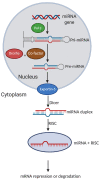Pathogenetic Role and Clinical Implications of Regulatory RNAs in Biliary Tract Cancer
- PMID: 33375055
- PMCID: PMC7792779
- DOI: 10.3390/cancers13010012
Pathogenetic Role and Clinical Implications of Regulatory RNAs in Biliary Tract Cancer
Abstract
Biliary tract cancer (BTC) is characterised by poor prognosis and low overall survival in patients. This is generally due to minimal understanding of its pathogenesis, late diagnosis and limited therapeutics in preventing or treating BTC patients. Non-coding RNA (ncRNA) are small RNAs (mRNA) that are not translated to proteins. ncRNAs were considered to be of no importance in the genome, but recent studies have shown they play essential roles in biology and oncology such as transcriptional repression and degradation, thus regulating mRNA transcriptomes. This has led to investigations into the role of ncRNAs in the pathogenesis of BTC, and their clinical implications. In this review, the mechanisms of action of ncRNA are discussed and the role of microRNAs in BTC is summarised. The scope of this review will be limited to miRNA as they have been shown to play the most significant roles in BTC progression. There is huge potential in miRNA-based biomarkers and therapeutics in BTC, but more studies, research and technological advancements are required before it can be translated into clinical practice for patients.
Keywords: LncRNA; biliary tract cancer; biomarker; miRNA; non-coding RNA; therapy.
Conflict of interest statement
The authors declare no conflict of interest.
Figures

Similar articles
-
Whole blood microRNAs capture systemic reprogramming and have diagnostic potential in patients with biliary tract cancer.J Hepatol. 2022 Oct;77(4):1047-1058. doi: 10.1016/j.jhep.2022.05.036. Epub 2022 Jun 21. J Hepatol. 2022. PMID: 35750139
-
Non-Coding RNA as a Biomarker in Lung Cancer.Noncoding RNA. 2024 Sep 30;10(5):50. doi: 10.3390/ncrna10050050. Noncoding RNA. 2024. PMID: 39452836 Free PMC article. Review.
-
Non-coding RNAs in endometriosis: a narrative review.Hum Reprod Update. 2018 Jul 1;24(4):497-515. doi: 10.1093/humupd/dmy014. Hum Reprod Update. 2018. PMID: 29697794 Review.
-
The Role of Circular RNAs in Pancreatic Ductal Adenocarcinoma and Biliary-Tract Cancers.Cancers (Basel). 2020 Nov 4;12(11):3250. doi: 10.3390/cancers12113250. Cancers (Basel). 2020. PMID: 33158116 Free PMC article. Review.
-
Development and validation of circulating protein signatures as diagnostic biomarkers for biliary tract cancer.JHEP Rep. 2022 Dec 13;5(3):100648. doi: 10.1016/j.jhepr.2022.100648. eCollection 2023 Mar. JHEP Rep. 2022. PMID: 36699667 Free PMC article.
Cited by
-
Molecular profiling of bladder cancer xenografts defines relevant molecular subtypes and provides a resource for biomarker discovery.Transl Oncol. 2025 Feb;52:102269. doi: 10.1016/j.tranon.2024.102269. Epub 2025 Jan 13. Transl Oncol. 2025. PMID: 39808845 Free PMC article.
-
Effects of combined use of compound acidifiers and plant essential oils in feed on the reproductive performance and physiological status of Xianjv chickens.Poult Sci. 2025 Feb;104(2):104710. doi: 10.1016/j.psj.2024.104710. Epub 2024 Dec 20. Poult Sci. 2025. PMID: 39764874 Free PMC article.
-
A practical distribution pattern of α-SMA-positive carcinoma associated fibroblasts indicates poor prognosis of patients with pancreatic ductal adenocarcinoma.Transl Oncol. 2025 Feb;52:102282. doi: 10.1016/j.tranon.2025.102282. Epub 2025 Jan 13. Transl Oncol. 2025. PMID: 39808844 Free PMC article.
-
Conversion therapy for advanced intrahepatic cholangiocarcinoma with lenvatinib and pembrolizumab combined with gemcitabine plus cisplatin: A case report and literature review.Front Immunol. 2023 Jan 9;13:1079342. doi: 10.3389/fimmu.2022.1079342. eCollection 2022. Front Immunol. 2023. PMID: 36700218 Free PMC article. Review.
-
Molecular mechanisms of mTOR-mediated cisplatin response in tumor cells.Heliyon. 2024 Dec 25;11(1):e41483. doi: 10.1016/j.heliyon.2024.e41483. eCollection 2025 Jan 15. Heliyon. 2024. PMID: 39834411 Free PMC article. Review.
References
Publication types
LinkOut - more resources
Full Text Sources

